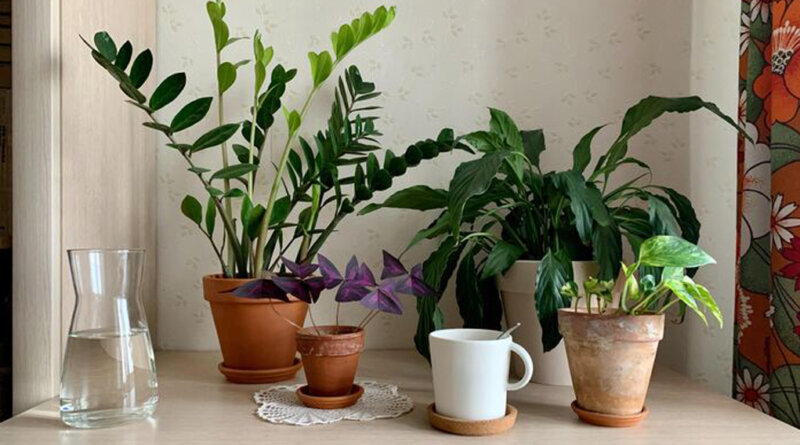What You Need to Avoid
Houseplants can be an eye-catching and vibrant addition to one’s home. But despite their attraction, some of these indoor plants may not be the best for dog owners.
This is because of substances such as saponins, oxalates, and alkaloids found in these indoor plants that are inherently dangerous for our four-legged friends.
Dogs are naturally curious and scent-oriented. They navigate the world through their sense of taste.
This increases their risk as they may eat the leaves of these plants, incurring adverse symptoms such as vomiting, diarrhea, difficulty breathing, and even seizures, etc.
As pet parents, we are responsible for ensuring our furry friends stay safe from the dangers of toxic indoor plants.
This blog post will address everything you need to know about this adversity.
Starting from common indoor plants to symptoms, treatment, and preventative measures, we’ll gradually discuss everything.
Common Indoor Plants That Are Toxic to Dogs
So, now we have established that certain indoor plants are toxic to dogs.
Your curious furry friend may always be predisposed to sniff its scent or chew its leaves, owing to its inquisitive instinctual nature.
This necessitates that you look around and scan all houseplants that are currently lying in your home.
You make a mental or physical checklist and slowly start researching their safety for dogs.
To simplify the task, we have compiled a list of the top five indoor plants that are toxic to dogs.
These may incur symptoms such as vomiting, diarrhea, loss of appetite, seizures, difficulty breathing, and even jaundice.
1. Philodendron
Philondredon is a popular choice for houseplants owing to its eye-catching greenery and ease of care.
These may not be the most suitable choice for pet owners due to the insoluble calcium oxalates in their tissues.
While its primary purpose is to keep the plant safe from herbivores and carnivores eating its leaves, our four-legged pets may be more insistent.
They may ingest its leaves, causing reactions such as drooling, pawing at the mouth, vomiting, and difficulty swallowing.
2. Pothos / Devil’s Ivy
The heart-shaped plant of the Pothos plant and its low maintenance makes it another outstanding choice amongst families.
Most people don’t know that Philodendron and Pothos originate from the same Araceae family and share a mutual toxicity towards pets.
These scenic house plants also produce insoluble calcium oxalate crystals, which may trigger reactions such as diarrhea and vomiting if ingested.
It may even lead to liver failure in severe (yet not uncommon) causes.
3. Dieffenbachia
The large, broad, oval-shaped leaves of Dieffenbachia may attract you.
You may even find its green, yellow, and white colors appealing, but that doesn’t undermine its toxicity to your affectionate pup.
The culprit remains the same: the calcium oxalate crystals here can cause irritation when ingested.
That may manifest into symptoms such as vomiting, diarrhea, and mouth swelling and may even be fatal if not treated immediately.
4. Snake Plant
The snake plant is known for long, aesthetic, sword-like leaves and effortless care.
Still, the plant is considered toxic for dogs and cats as it contains saponin, which may be harmful if ingested in large quantities.
It is worth noting that the reactions these incur are related to the amount your pet eats.
They may only experience mild symptoms such as vomiting and diarrhea.
In contrast, a large amount may cause symptoms such as difficulty breathing and seizures.
5. ZZ Plant
The glossy, dark leaves and the long, graceful stems of the ZZ plant may attract anyone. It’s easy to care for and may even be the cherry on top.
That won’t stop the calcium oxalate crystals from being less harmful to your active pet. It is worth noting that this plant is toxic to humans and animals.
Still, the frequency of symptoms may be less observable in humans as we wash our hands and faces more often, wearing off the effect.
Since that is not the case for dogs, it may incur symptoms such as vomiting, diarrhea, and abdominal pain and even be fatal in severe cases.
Symptoms of Plant Poisoning in Dogs
So, let’s suppose your furry friend has been sick lately, and you suspect the snake plant in your home is the underlying cause.
What symptoms may your dog exhibit when it has ingested the leaves of a toxic plant? Let’s find out!
1. Gastrointestinal issues
Gastrointestinal issues refer to any problem that occurs in any organ of the dog’s digestive system.
This includes the mouth, salivary glands, esophagus, stomach, small intestine, liver, large intestine, and anus of the dog.
Each part of the system plays an integral role in maintaining overall health. Any malfunction may lead to your dog facing discomfort and pain, depending on the severity.
2. Drooling
Drooling is a common sign of ingestion of toxic substances in dogs.
Their body’s natural defense is to protect your pet against the hazard by flushing it out of its system through the mouth.
This helps minimize the amount of toxicity absorbed by going into the bloodstream. Instead, it comes out through the mouth as saliva.
3. Vomiting
Consuming a toxic substance can irritate the stomach lining.
This may lead to symptoms such as nausea and vomiting to prevent the hazard from going into the bloodstream and flushing it out instead.
It is worth noting that vomiting may not eliminate all the danger.
Depending on the amount of the plant eaten, it may require medical treatment, such as activated charcoal or IV fluids.
4. Diarrhea
Toxic plants like Philodendron and Pothos may irritate the stomach lining and cause inflammation.
This may further lead to changes in the consistency and frequency of bowel movements.
The intestines quickly come to the rescue by attempting to flush all the toxicity out of the body through the anus.
5. Lethargy
Have you ever felt tired, exhausted, and sleepy while sick? The same is the case for dogs.
That is because dangerous substances may directly affect the nervous system, leading to a lack of energy.
In other cases, it may also be due to decreased oxygen supply to the brain, leading to fatigue and exhaustion.
It is important to remember that severe cases may lead to difficulty breathing, seizures, and even a comma.
We recommend consulting a veterinarian as soon as the dog starts showing symptoms. The earlier the diagnosis, the more effective the treatment will be.
Treatment for Plant Poisoning in Dogs
Even if your pet has ingested any toxic plants and gotten plant poisoning, don’t worry.
Depending on the dog’s breed, size, age, and overall health, it’s completely treatable.
Here, we have compiled a list of five practical and actionable step-by-step things to do when your furry friend is suffering from plant toxicity:
Consult your local veterinarian immediately
There’s nothing worse than diagnosing your pet’s condition and attempting to treat it yourself.
A professional will be much more qualified for the job and may devise a treatment based on your furry friend’s unique needs.
Prescriptions that induce vomiting
They may ask you a few questions and do a general health checkup before choosing a suitable action.
Your pet doctor may ask you a few questions and do a general health checkup before selecting an appropriate action.
It is important to remember that this step must never be done without a professional’s direct supervision and guidance.
Activated charcoal
It is a fine black powder that prevents toxins from entering the bloodstream. It may be mixed with water or food and given orally at intervals.
Again, this should only be done under the guidance of a veterinarian.
IV fluids
They can help provide additional support to the organs and minimize weakness.
That may assist in reducing the effects of dehydration caused by vomiting and diarrhea.
The veterinarian will give the number of fluids and the methodology, depending on his examination of the dog’s condition.
Monitoring the dog’s condition
More often than not, healing is not a linear phase.
Your dog may go through intervals of improvement and deterioration, so it’s important to look for symptoms that may indicate it.
For example, your dog may become more active as it feels more energetic or become lethargic as the weakness overcomes.
Medications for other symptoms
You must follow through with the prescribed treatment and inform him of any significant observable changes in your furry friend.
Preventing Poisoning in Indoor Plants Toxic to Dogs
Dogs are curious and scent-oriented by nature. This means they will go and sniff plants you’ve placed in your home.
This may be a problem if the plant contains substances or components that harm our beloved dogs.
As pet parents, we are responsible for ensuring our furry friends’ safety, health, and wellness.
Tips for Keeping Toxic Plants Away From Dogs
When keeping plants away from dogs, it is important to remember that it’s all about caution.
The more you try to put yourself in your dog’s shoes, the more you can identify how they may access them.
Once you know the doggo instincts and methodology, you’ll become increasingly effective at eliminating all potential hazards and keeping dangers at a distance.
Here are our top 4 tips on preventing plant poisoning in dogs.
Know which plants are toxic
This is self-explanatory. Knowing which plants are toxic for your adorable pup will allow you to avoid them.
You may also give them to someone else or place them at a place inaccessible to your dog.
Since your curious and active pet won’t be able to reach it, it’ll reduce the likelihood of triggered allergies or bad symptoms by a significant margin.
Choosing dog-friendly plants
Now that you have emptied the space once occupied by toxic plants for dogs, it is time to fill it with something new.
Sure, it could be a beautiful decoration piece, but it could also be another dog-friendly plant.
You may choose from various choices, including spider plant, Boston fern, bamboo palm, areca palm, African violet, etc.
Keeping plants out of reach
If you’re unsure whether a plant is good or bad for your dog, the easiest tip is to store it in a place inaccessible to your dog.
You may place them on high shelves, hanging baskets, countertops, etc.
Your dog will be away from the potential hazards of these plants, which may assist in preventing symptoms such as seizures and gastrointestinal problems, etc.
Training dogs to avoid plants
Ultimately, dogs are highly trainable creatures. You can discipline them into behaving a certain way through positive reinforcement methods.
This means setting a time interval and rewarding your pet with its favorite treats every hour he does not approach the plant.
Then, you may increase the gap until the habit is cemented.
Using deterrents
Did you know that citrus peel and vinegar can be natural deterrents for dogs?
Once you have applied them directly to the plant, your pet may automatically avoid going near them.
You may also use bitter-tasting and motion-activated sprays to prevent your pet from approaching them.
The latter will spring up whenever it detects something near it, startling the dog, until it stops going near the plant entirely.
Indoor Plants Toxic to Dogs: Conclusion
Indoor plants are an excellent addition to enhance the aesthetic appeal of our homes, but we must be careful when making the selection.
Our adorable pets may not be able to bear the toxins in some of these plants. As said, prevention is better than cure.
We recommend thoroughly researching whichever plant you feel inclined to purchase and checking their suitability for dogs.
Remember: even if your dog ingests any toxic plant, healing is always possible. Do not fret and consult a veterinarian immediately.
They will guide you on the suitable protocols depending on the dog’s age, breed, size, and overall health conditions.
Your furry friend will adore their parents acting responsibly and taking care of their health and wellness.
READ NEXT: The Ultimate List of Toxic and Safe Plants, Seeds for Dogs











